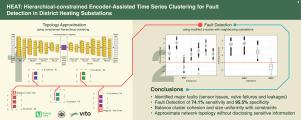热:层次约束编码器辅助时间序列聚类在区域供热变电站故障检测中的应用
IF 9.6
Q1 COMPUTER SCIENCE, ARTIFICIAL INTELLIGENCE
引用次数: 0
摘要
区域供热(DH)变电站的故障检测对于保持能源效率至关重要。然而,现有的方法往往不足,依赖于标记数据或全局分析,可能会错过细微的异常。我们介绍了HEAT,一种层次约束编码器辅助时间序列聚类方法,旨在增强DH变电站的故障检测。HEAT以两阶段的方式运行:首先,它使用供应温度分布的约束分层聚类算法近似相对网络拓扑。HEAT采用卷积自动编码器(CAE)来降低时间序列数据的维数,并在链接功能中使用自适应软约束,在支持领域知识的同时,使用约束矩阵支持最小和最大簇大小约束,例如,必须链接和不能链接约束。其次,我们使用拓扑近似使用平均绝对偏差(MAD) z分数执行簇内分析,邻近的变电站作为验证机制,允许在不需要标记数据的情况下进行稳健分析。实验结果表明,HEAT方法在故障检测上的灵敏度为74.1%,特异度为95.5%,明显优于传统的聚类方法。HEAT不仅可以识别主要故障(例如传感器问题、阀门故障),还可以检测细微异常(例如二次泄漏),同时最大限度地减少误报。这种无监督的方法为DH网络提供了一种可行而灵活的解决方案,在不泄露敏感信息的情况下提高了运行效率和能源可持续性。本文章由计算机程序翻译,如有差异,请以英文原文为准。

HEAT: Hierarchical-constrained Encoder-Assisted Time series clustering for fault detection in district heating substations
Fault detection in district heating (DH) substations is crucial for maintaining energy efficiency. However, existing methods often fall short and rely on labelled data or global analysis that may miss subtle anomalies. We introduce HEAT, a Hierarchical-constrained Encoder-Assisted Time series clustering method designed to enhance fault detection in DH substations. HEAT operates in a two-phase approach: first, it approximates a relative network topology using a constraint hierarchical clustering algorithm on supply temperature profiles. HEAT incorporates a Convolutional AutoEncoder (CAE) for dimensionality reduction of the time series data and uses adaptive soft constraints in the linkage function, enabling both minimum and maximum cluster size constraints while supporting domain knowledge, e.g., must-link and cannot-link constraints, using a constraint matrix. Second, we use the topology approximation to perform intra-cluster analysis using Mean Absolute Deviation (MAD) z-scores, with neighbouring substations serving as a validation mechanism, allowing for robust analysis without requiring labelled data. Experimental results demonstrate that HEAT outperforms conventional clustering methods while achieving 74.1% sensitivity and 95.5% specificity in fault detection, significantly improving over typical global analysis. HEAT not only identified major faults (e.g., sensor issues, valve failures) but also detected subtle anomalies (e.g., secondary leakages) while minimising false positives. This unsupervised method offers a viable and flexible solution for DH networks, improving operational efficiency and energy sustainability without disclosing sensitive information.
求助全文
通过发布文献求助,成功后即可免费获取论文全文。
去求助
来源期刊

Energy and AI
Engineering-Engineering (miscellaneous)
CiteScore
16.50
自引率
0.00%
发文量
64
审稿时长
56 days
 求助内容:
求助内容: 应助结果提醒方式:
应助结果提醒方式:


